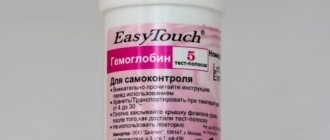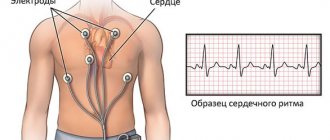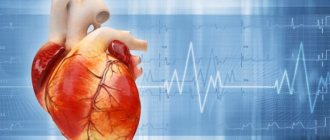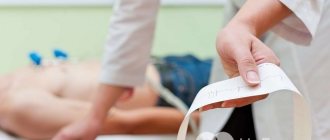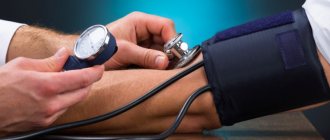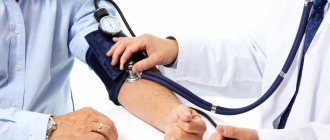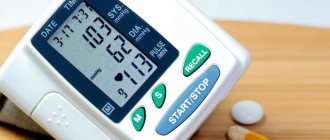In order to talk about why a low pulse occurs (bradycardia), it is necessary to recall a little the anatomy and electrophysiology of the heart.
The heart has two atria and two ventricles. First, the atria contract, driving blood into the ventricles of the heart, then the ventricles contract, throwing blood into the largest vessel, the aorta, and through it the blood is distributed to all organs and tissues.
What makes the heart beat?
Like any organ, the heart has a conducting system, in other words, wires through which “current” flows to its various parts. The “electric current” originates spontaneously in the sinus node (a small point in the wall of the right atrium). This node is necessary for generating an impulse and adjusting the frequency of contractions depending on the needs of the body, for example, when we run it speeds up the heart, and when we sleep it slows it down.
From the sinus node, the impulse first goes to the atria, causing them to contract. Then the “wires” merge into one so-called “switch” or AV node (it is located in the middle of the heart between the atria and ventricles, in this node there is a slight delay in the passing “current” for the full contraction of the atria), then the impulse passes to the ventricles. In the ventricles, the “wires” branch and are called the bundle branches (left and right; the left, in turn, is further divided into the anterior branch and the posterior branch) with their help, the impulse causes contraction of the ventricles of the heart.
Prevention measures
To treat hypotension, it is important to identify and eliminate its cause. Normalizing blood pressure will relieve poor health and tachycardia. If the patient is prone to low blood pressure, it is important to consume sufficient amounts of fluid and salt and ensure regular moderate physical activity. Movement improves blood circulation in the vessels and helps maintain normal blood pressure.
If you have hypotension, you should avoid severe stress and activities that involve physical and emotional stress. To feel well, it is important for hypotensive patients to get a good night's sleep and rest properly.
Water procedures have a positive effect: contrast showers, hydromassage. It is important that temperature changes are not too sudden.
Why might your heart rate drop?
Unfortunately, this entire system can break down at different stages and lead either to a decrease and/or cessation of the flow of “current” (blockade) or to incorrect conduction of the impulse in various parts of the heart:
- The first “breakage” may be at the level of the sinus node itself. For various reasons, organic or functional, it loses the ability to produce the required number of impulses. For example, no matter how much a person runs or climbs the stairs, the sinus node cannot rise above a hundred beats, which may result in increased shortness of breath or weakness.
- The second “breakage” may be at the level of the atrioventricular (AV) node. Let me remind you that it is located between the atria and ventricles, an impulse passes through it from the atria to the ventricles; it is needed in order to create a short physiological pause for a more complete contraction of the atria. At this level, all kinds of blockades (AV blocks) can occur. They come in different degrees, 1st, 2nd or 3rd degree depending on the severity of the condition. From the name it is clear that they block the impulse at this stage, as a result the ventricles of the heart cannot contract, this leads to pauses, sometimes significant ones (3 or more seconds); for example, depending on the body’s reserves and concomitant pathology, starting from a 3-second delay in heart contraction, a person may begin to briefly lose consciousness; as these blockades progress, consciousness, sometimes, may not return. Let us reassure you a little: nature has come up with life-saving “(emergency) stations” for generating backup impulses; they are located at all stages of the conduction system, but the “lower” they are located, the less “current” they are able to reproduce. So, in case of this breakdown, the “backup generator” is already in the ventricles and is capable of delivering a maximum of 40 beats or less, so that this can allow one to “hold out” to the resuscitation ambulance team.
- The third “breakdown” can occur below the atrioventricular (AV) node at the level of the bundle branches (these are “wires” that extend from the atrioventricular node and excite the ventricles; we will talk about them in more detail in another article).
Unfortunately, these legs can also be partially or completely blocked due to various reasons, thereby preventing the full contraction of the ventricles of the heart.
Symptoms
In addition to rapid heartbeat, patients with tachycardia at low blood pressure note the following signs of pathology:
- weakness and drowsiness, decreased performance;
- dizziness, headache;
- violation of movement coordination;
- darkening of the eyes;
- pale skin, sweating;
- feeling of lack of air;
- nausea that progresses to vomiting.
In severe cases, a drop in pressure leads to loss of consciousness.
What causes these “breakdowns” in the conduction of impulses?
- Diseases leading to overload and hypertrophy of the ventricles such as cor pulmonale, congenital and/or acquired heart defects with increased load on the right and/or ventricles (for example, mitral and aortic stenosis/insufficiency or septal defects), arterial hypertension, myocardial infarction various localizations, cardiomyoptia, myocardial dystrophy, etc.
- Various congenital anomalies of the development of the cardiac conduction system (Brugada syndrome)
- Age-related changes (cardiosclerosis)
- Idiopathic (acting as a separate disease, causeless) calcification or sclerosis of the cardiac conduction system
- Also, a low heart rate in itself can be normal in trained athletes (it can reach up to 35 beats per minute)
- changes in the electrolyte composition of the heart (hyperkalemia or hypercalcemia)
- Non-cardiac causes (increased intracranial pressure, decreased body temperature, hypothyroidism, etc.)
Tips for people with hypertension
If you have high blood pressure, you should be especially careful when choosing means to raise your heart rate. They should be gentle and, preferably, have a calming effect.
It is best for the medications to be prescribed by a doctor, but without his recommendation you can use:
- Corvalol is a medicine with a complex composition: mint oil increases the pulse, and valerian root with Phenobarbital has a calming effect and reduces blood pressure.
- Green tea without additives. It is able to normalize blood pressure, so it will not cause harm, even if it is elevated. But such tea should be drunk without additives, and it should be of good quality.
How to treat this disease
In order to lower blood pressure and normalize the pulse, it is recommended to carry out therapeutic therapy. Before doing anything to increase the heart rate, you need to familiarize yourself with the features of treating pathologies.
First aid
If there is a sharp deterioration in the pulse, it is imperative to provide first aid in order to quickly eliminate the symptoms of a decrease in pulse and normalize blood pressure. To do this, the patient is placed on his back and a cold compress is applied to the lower back. Respiratory therapy will help improve the patient's well-being. It not only normalizes breathing, but also calms the patient. It is also advisable to take vasodilators to improve blood circulation.
Medications
When treating pathology, doctors advise using drugs that can normalize blood circulation and heartbeat.
Effective drugs include:
- "Anaprilin." The drug is used to eliminate hypertension and its complications. Before using the drug, it is better to consult a doctor, because Anaprilin is not suitable for all people with bradycardia.
- "Valoserdin." The drug is used to eliminate hypertension at an early stage of development. It is recommended to drink Valoserdin for no more than a week, since long-term use of the drug causes bromine poisoning and addiction.
- "Concor". Many experts recommend using this drug for heart failure and high blood pressure. Drink no more than 10 mg of the drug per day, since an overdose causes insomnia, convulsions and dizziness.
Folk remedies
Medicines do not always help stabilize the pulse and cope with hypertension. That's why some people use folk remedies instead of medicines. Effective folk remedies include:
- Radish juice. To obtain juice, cut a small hole in the vegetable and pour a tablespoon of sugar and honey into it. Then the radish is pressed for an hour and a half, after which you can use the prepared infusion.
- Italian nuts. To prepare a walnut remedy, mix 400 grams of peeled nuts with 80 grams of sugar and 200 ml of sesame oil. Then pour hot water into it and add lemon juice. The liquid prepared in this way is poured into a separate container and left for 12 hours.
Preventive measures
Primary prevention should be carried out before signs of pathology appear. Preventive measures include:
- Physical activity. To strengthen your immune system and improve your health, you need to be physically active. You should not overload the body, and to prevent hypertension, cycling, jogging and brisk walking are sufficient.
- Avoid stress. Mental stress often causes high blood pressure, so it is worth dealing with it. This includes breathing exercises, self-study and meditation. Being in nature and spending time with pets can also help reduce stress.
- Quitting bad habits. To prevent the occurrence and development of hypertension, you should stop drinking alcohol and smoking.
Diagnostics
If you experience symptoms of a weak heartbeat and increased blood pressure, you should immediately consult a doctor. This will allow timely identification of the causes of the pathology and determine the most effective methods of its treatment.
During diagnosis, the following tests are performed:
- Electrocardiography. The procedure is carried out to study in detail the characteristics of the electric fields that arise during the heartbeat. With its help, any violations in the functioning of the organ are determined.
- ULTRA-HEARING. Echocardiography is often used to examine the heart to determine the causes of high blood pressure. Such an examination allows doctors to study in more detail the condition of the vessels and internal walls of the organ. It is recommended to undergo regular ultrasound examinations to promptly detect cardiovascular diseases.
- General blood analysis. This is a fairly common method for diagnosing many diseases. The test measures the number of proteins, white blood cells and platelets in the blood. A correctly performed analysis will allow timely identification of the disease that causes high blood pressure.
Diet
During therapy, it is recommended not only to carry out a therapeutic course, but also to eat properly. It is necessary to adhere to the following recommendations that will enhance the result of treatment:
- switching to fractional meals in small portions 5-6 times a day;
- Limiting the consumption of fried and fatty foods;
- Limiting the consumption of salty foods, which increase blood pressure;
- Avoid hard and carbonated drinks;
- limiting fluid intake to one and a half liters per day.
Before creating a diet, it is best to consult a nutritionist for help in choosing the healthiest foods.
How to quickly normalize blood pressure at home
There is a universal remedy that lowers blood pressure and increases heart rate in people of any age. The drug is made from garlic, which contains ingredients to quickly lower blood pressure at home.
To prepare garlic tincture, you need to wash 350 grams of vegetables, peel them and grate them. Pour 200 ml of chopped garlic with alcohol and leave for a week and a half. Then the infusion is filtered through cheesecloth, poured into a new container and infused again for five days. To increase heart rate and lower blood pressure, it is recommended to drink the tincture three times a day, half an hour before meals. In this case, it is enough to drink one drop of the drug in the morning, two drops in the afternoon and three in the evening. Over the course of a week, the dose is increased to 15 drops per day.

